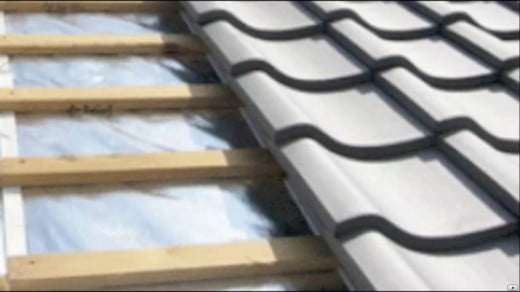Understanding Radiant Barrier Under Shingles

Thinking about installing a radiant barrier under your shingles? A radiant barrier can be an extremely effective way of reducing heat gain in your home and increasing energy efficiency - but as with so many things, it only works if it's done right. It sounds simple enough - you're re-shingling your roof, so why not just layer the roofing felt, some radiant barrier foil, and then the new shingles? Presto, instant radiant barrier, right?
Unfortunately, no. While it can be done, a quick lesson in simple physics will show you why installing a radiant barrier under shingles isn't quite this easy. Radiant heat, by definition, is the transfer of heat from one item to another without touching. To be technical about it, radiant heat is electromagnetic radiation that travels in a waveform across a void. Ever hold your hands up to a fire? You feel the warmth of the flames, but you're not touching them - that's radiant heat. Radiant heat does not exist without space between objects, and without radiant heat you have no radiant barrier. When you simply layer radiant barrier foil and shingles with no space in-between, you're dealing with conductive heat instead – the type of heat transfer that would happen if you actually put your hand in the fire. Conductive heat cannot make a radiant barrier.
Helpful links
- Attic Foil Radiant Barrier - Radiant Barrier Directly Under Shingles - Does NOT Work!!
Installing radiant barrier SANDWICHED between the shingles and the roof deck (no air gap) will not help and will actually INCREASE heat through the roof. - The Effect of Radiant Barriers on Shingle Temperatures | The Radiant Barrier Guru
Tests have shown that installing a radiant barrier in attics generally only cause the roof and shingles to warm slightly. So how does radiant barrier help? - Thermal radiation - Wikipedia, the free encyclopedia
Thermal radiation is electromagnetic radiation emitted from a material which is due to the heat of the material, the characteristics of which depend on its temperature. - Energy Savers: Insulation and Air Sealing
Unless your home was specially constructed for energy efficiency, you can usually reduce your energy bills by adding more insulation.
Although professional roofers should know better, some persist in offering foil-coated roofing underlayments, such as Polaralum®, as a radiant barrier. These roofers – whether mistaken or willfully misrepresenting the product – are trying to sell you something that doesn't exist. No product can work as a radiant barrier when placed directly under shingles, even if it is designed to be a radiant barrier in other situations. In fact, the manufacturer of Polaralum® clearly states that their product acts as a thermal barrier on roofs – not a radiant barrier.
While installing a green energy barrier is not as simple as just adding an extra layer to the shingling process, it can still be done economically and with a minimum of fuss. What you need to do is create an air space between the radiant barrier foil and the roofing material. Some roof types, like standing seam metal roofs and barrel-type roofing tiles, naturally have an air space between the roof deck and the roofing material.

You can also use wood battens to create the necessary space. After you have covered the roof deck with roofing felt and a layer of perforated radiant barrier foil, simply install the battens according to the manufacturer's instructions. The roofing material can then be attached over the battens, maintaining an air space between the foil and the shingles. To allow for maximum airflow, “notch” the battens or leave spaces between them.
Installing a radiant barrier as part of your new roof can be a smart move, but only if it is done correctly. An effective radiant barrier is like built-in shade for your roof – it will reflect heat away from your home, lowering energy costs while increasing comfort. Just be sure that you're truly receiving a radiant barrier and not simply shelling out money for an extra layer on your roof that actually provides no additional benefit.



